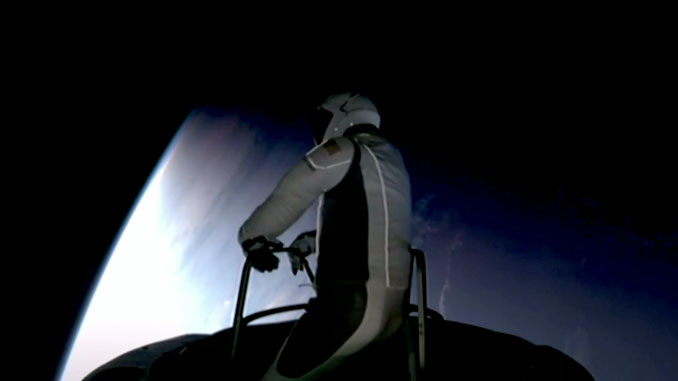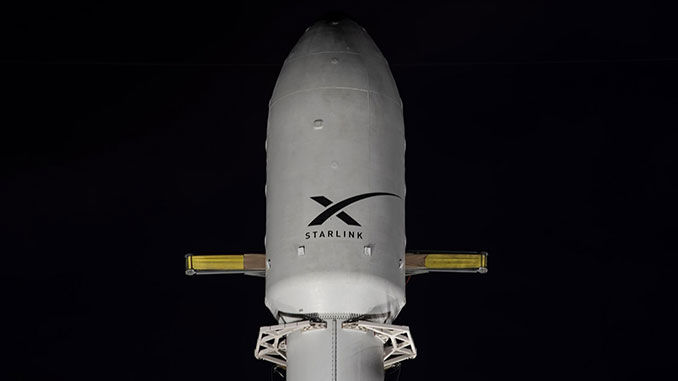
In another SpaceX milestone, billionaire Jared Isaacman and company crew trainer Sarah Gillis took turns floating just outside their Crew Dragon capsule early Thursday in the first privately-financed spacewalk in the history of space exploration.
As he took in his first unobstructed look at the Earth 458 miles below, Isaacman marveled at the serene, boundary-free view, saying “back at home, we all have a lot of work to do. But from here, it sure looks like a perfect world.”
With Polaris Dawn crewmates Anna Menon and Scott Poteet monitoring safety tethers and umbilicals inside the SpaceX Crew Dragon, airless with its hatch open, Isaacman floated out into open space around 6:51 a.m. EDT, using a scaffold-like “Skywalker” framework for stability.
While his feet were just outside the hatch, he did not “free float” away from the Crew Dragon. The Space-X designed pressure suits were not equipped with their own oxygen supply or other life support equipment and relied instead on the 12-foot-long umbilicals to deliver air, power and communications.
As Isaacman and then Gillis floated one at a time just outside the hatch, they tested the comfort and mobility of their pressurized extra-vehicular activity, or EVA, suits, moving their arms, hands and legs through a series of positions to find out how much effort is required to carry out basic tasks.
“We’re going to make use of various mobility aids the SpaceX team has engineered, and it’ll look like we’re doing a little bit of a dance,” Isaacman said before launch. “The idea is to learn as much as we possibly can about this suit and get it back to the engineers to inform future suit design evolutions.”
Cameras mounted inside and outside the Crew Dragon, along with others attached to the spacewalkers’ helmets, provided wide-angle views of space and the Earth below as the ship sailed through an elliptical orbit with a low point of 121 miles and a high point of 458 miles — 200 miles higher than the International Space Station.
“It’s gorgeous,” Isaacman said, taking a moment to take in the view after carrying out his portion of the mobility tests.
The goal of the one-hour 46-minute spacewalk was to help company engineers perfect low-cost, easy-to-manufacture spacesuits for use by future commercial astronauts flying to the moon or Mars aboard SpaceX Super Heavy-Starship rockets.

“Building a base on the moon and a city on Mars will require thousands of spacesuits,” SpaceX said on its website. “The development of this suit, and the EVA performed on this mission, will be important steps toward a scalable design for spacesuits on future long-duration missions.”
Isaacman, Poteet, Menon and Gillis blasted off Tuesday from the Kennedy Space Center atop a SpaceX Falcon 9 rocket. The crew accomplished the first major goal of the flight right off the bat, climbing to an altitude of 870 miles — higher than any piloted spacecraft since the Apollo moon program 60 years ago.
The high point, or apogee, of the orbit then was lowered to 458 miles for the spacewalk and the remainder of the five-day mission.
To prevent decompression sickness, or the bends, during the crew’s transition from sea-level pressure to the reduced 5 psi pressure in their spacesuits and back, flight controllers began a 45-hour process shortly after launch to boost oxygen levels in the cabin while slowly decreasing air pressure to help remove nitrogen from the crew’s bloodstreams.
“We don’t anticipate experiencing (the bends), because a ton of robust preparation has gone into developing this pre-breathe protocol, significantly reducing that risk,” said Menon, a former biomedical flight controller for NASA. “But we’re prepared if we need it.”
The Crew Dragon does not have an airlock and its life support system was not designed to support spacewalks. Required modifications included “adding a lot more oxygen to the spacecraft so that we can feed oxygen to four suits through umbilicals for the full duration of the spacewalk,” Gillis said.
“There have been upgrades and additions to the environmental sensing suite in the spacecraft to make sure we have really good insight, both before, during and after exposure to vacuum. And … an entirely new system, a nitrogen repress system” to boost the cabin back up to normal pressure after the spacewalk.
Along with the Skywalker scaffold, which extends just beyond the forward hatch, a motor drive system was added to assist with hatch opening and closing and upgraded seals were put in place to ensure an airtight fit.
Comonaut Alexei Leonov carried out the first spacewalk on March 18, 1965, followed three months later by NASA astronaut Ed White, the first U.S. spacewalker. Since then, NASA astronauts, Russian cosmonauts, Chinese taikonauts and astronauts from space station partner nations have carried out more than 470 government-sponsored spacewalks.
Isaacman said iconic photos of White floating outside his Gemini capsule against the backdrop of Earth and space were inspirational, but he and Gillis ruled out floating free of the Crew Dragon. And that was by design.
“We’re not going to be doing the Ed White float,” Isaacman told CBS News before launch. “That might look cool, but it doesn’t really help SpaceX learn a lot about the performance (of the spacesuit). It’s not very useful or helpful for figuring out how to be able to to work in a suit.”
To that end, he and Gillis worked through a “matrix” of choreographed motions to get a feel for how the suit’s multiple joints move while pressurized, to test the performance of an innovative heads-up display in the helmet, better understand how the air-cooled suits deal with the extreme temperatures of space and a variety of other factors.
The suit “includes all sorts of technology, including a heads-up display, a helmet camera, an entirely new architecture for joint mobility,” Gillis said. “There’s thermal insulation throughout the suit, including a copper and indium tin oxide visor that both provides thermal protection and solar protection.”
In addition, she said, “there’s all sorts of redundancy, both in the oxygen supply feed to the suit, as well as all of the valves, all of the seals across the suit. It’s an incredible suit.”
The heads-up display, which will project critical data on the lower left side of the helmet visor, is a feature NASA’s decades old space station suits do not have.
“During the EVA, we’ll have insight into our suit, pressure, temperature, relative humidity and then also an understanding of how much oxygen we’ve used throughout the EVA. So some key pieces of telemetry right there. And it’s it’s really cool (that) with any lighting you can still see it.”
The Polaris Dawn mission is the first of three planned by Isaacman, an entrepreneur and philanthropist who owns and pilots his own MiG-29 fighter jet, in cooperation with Musk. The second flight will be another Crew Dragon mission while the third will be the first piloted flight of SpaceX’s huge Super Heavy-Starship rocket, now under development in Texas.
It’s not known how much Isaacman is paying for the flights or how much SpaceX funded on its own. Asked if he could share any details about the Polaris Dawn financing, Isaacman said “not a chance.”
The mission, SpaceX’s fifth commercial Crew Dragon flight to orbit and its 14th including NASA flights, is expected to last five days, ending with splashdown off the coast of Florida.



